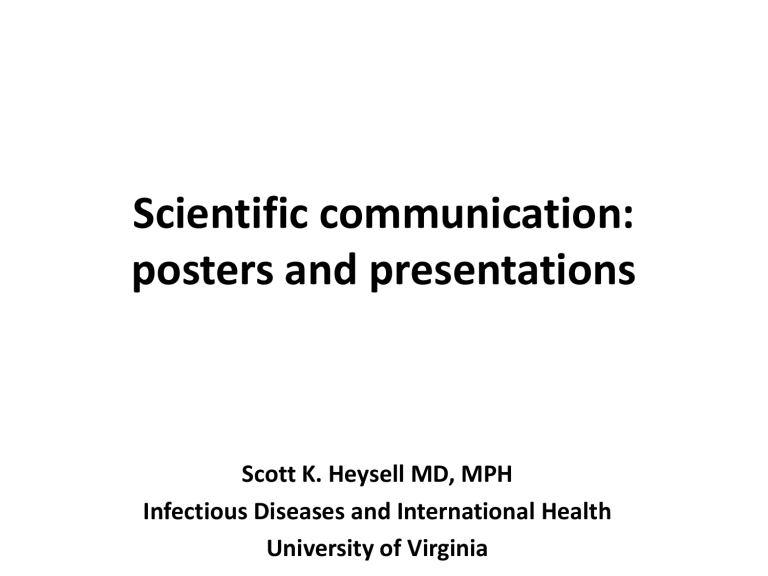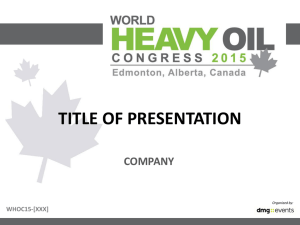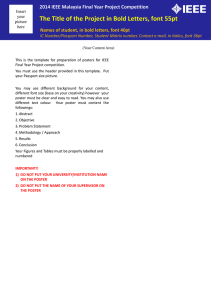Scientific communication: posters and presentations

Scientific communication: posters and presentations
Scott K. Heysell MD, MPH
Infectious Diseases and International Health
University of Virginia
All scientific communication is (polite) argument
▪ Grant
▪ Manuscript
▪ Meeting presentation/poster
▪ Editorial/ letter to the editor
▪ Peer review of another’s manuscript
▪ Letter of recommendation
Why did you perform the experiment?
Why are your results important?
How does your work impact your field of study?
Know your audience and the context
▪ Peers
▪ Colleagues familiar with your work
▪ Experts in your field
▪ Experts in a separate but related field
▪ Non-scientific or non-medical community
Stairwell conversation
Tea time conversation
Your thesis dissertation
Stairwell conversation
“Tuberculosis treatment outcomes are poor, we think in part because of inadequate drug combinations and dosages. We designed a test to see how well a TB patient’s plasma kills their own TB. We hope to use the test to optimize the drug regimen.”
“Looking forward to your lecture this week!”
Tea time conversation
“We believe TB drug regimens can be optimized to improve treatment outcomes. Low circulating drug levels are common but require a lot of resources and expense to measure and their clinical significance remains unclear. We developed a test to measure the killing of a patient’s own plasma while on TB treatment that could be performed in any lab with a MGIT machine. We found the assay correlated well drug levels, particularly for isoniazid and rifampin, the two most important drugs in first-line regimen. In Tanzania, patients had low drug levels and poor plasma killing.”
“Can you please pass the sugar?”
Thesis dissertation
“TB drug regimens can be optimized to improve treatment outcomes, but are dependent upon both achievable drug level and
M. tuberculosis MIC. In our study of the TB drug activity assay (TDA) where we co-cultured plasma from TB patients with their own M. tb isolate, we found a better correlation with TDA and drug level/ MIC, than to drug level alone. This occurred despite low drug levels that were still well above the MIC. Not only can TDA serve as an estimate of drug levels in settings without access to HPLC, we think it should be studied in the context of optimizing Cmax/ MIC for key drugs within both a drug-susceptible and a MDR-TB regimen.”
“Would you like to fund my grant?”
Components of a scientific poster
A descriptive title in large font, often referencing the study design
People read here
Authors names and institutions
Abstract
Optional to include
Methods Results Conclusions
Background
Implications
Photo
10
Results
5
0
1
2
3
Results
Data x y
4
5
6
7
8
9
Support/
Contact
Now some examples of my own posters for you to criticize
( load other powerpoint slides)
Someone stops at your poster:
Introduce yourself
Proceed with the “stairwell” conversation
If they appear interested:
Offer to walk them through the key results
Proceed with the “tea time” conversation
If they are still listening, asking questions:
Emphasize the conclusions/implications
Proceed with the “thesis dissertation”
Components of a 10 minute oral presentation for scientific meeting
( Leaving 3-5 minutes for questions )
Title page 1 slide 30 seconds
Background 1 (maybe 2) slides 1-2 minutes
Methods 2-3 slides 2-3 minutes
Not much time, use wisely
Results 3-4 slides (figures/ tables) 4-5 minutes
Conclusions 1 slide 1 minute
Implications 1 slide 1 minute
Acknowledgements only if not in title page 1 slide < 30 seconds
Choose the right color font/ background
Or else you will lose your audience
(this font is too small)
Black font / white background
Yellow font/ blue background
Black font/ yellow background
24 point font is the smallest to use
(practice projecting presentation with a colleague before)
Choose the right color font/ background
Or else you will lose your audience
(this font is too small)
Black font / white background
Yellow font/ blue background
Black font/ yellow background
24 point font is the smallest to use
(practice projecting presentation with a colleague before)
Choose the right color font/ background
Or else you will lose your audience
(this font is too small)
Black font / white background
Yellow font/ blue background
Black font/ yellow background
24 point font is the smallest to use
(practice projecting presentation with a colleague before)
(An example of what not to choose)
Choose the right color font/ background
Or else you will lose your audience
(this font is too small)
Black font / white background
Yellow font/ blue background
Black font/ yellow background
24 point font is the smallest to use
(practice projecting presentation with a colleague before)
Keep powerpoint art to a minimum
But it is acceptable to use a header line that does not distract and is kept throughout
Header font
and text font should be kept the same size throughout
Small icons of university or affiliation are common in bottom or top corners, particularly for title page
Example of Title and Background slides
Blood Cultures for the Diagnosis of
Drug-resistant TB in Rural South Africa
ASTMH Annual Meeting, 2009
Scott K. Heysell MD, MPH
Infectious Diseases and International Health
University of Virginia
Tugela Ferry Care and Research Collaboration on behalf of:
Tania A. Thomas, Neel R. Gandhi, Anthony P. Moll,
François Eksteen, Yacoob Coovadia, Lynne Roux,
Palav Babaria, Umesh Lalloo, Gerald Friedland and N. Sarita Shah
TF CARES
T ugela F erry Ca re and Res earch
Collaboration
Tugela Ferry, KwaZulu-Natal, South Africa
South Africa TB incidence: 948/100,000
Tugela Ferry
South Africa TB pts co-infected with HIV: 44%
Tugela Ferry ~80-90%
2006-2008 >650 cases of MDR and XDR-TB from Tugela Ferry
Tugela Ferry TB mortality*:
MDR-TB 71%
XDR-TB 83%
*Gandhi, AJRCCM 2010.
Drug-resistant TB
• Multi-drug resistant (MDR)-TB= resistant to isoniazid and rifampicin
• Extensively drug-resistant (XDR)-TB= MDR plus resistance to at least one fluoroquinolone and one second-line injectable agent (capreomycin, kanamycin, amikacin)
Examples of a Results slide
Majority of slow responders in Virginia had low C
2hr of isoniazid (INH) and rifampin (RMP) levels
39 patients had testing to both INH and RMP:
32 (82%) had low levels to either medication
Increasing RMP or INH concentration results in greater TB drug activity
5
4,5
4
*
TDA
3,5
3
†
2,5
2
* †
1,5
1 static
0,5
0
RMP 0
MIC: [INH <0.03, RMP 0.25]
RMP 4 RMP 8
Rifampin (RMP) concentration µg/ml
RMP 16
Isoniazid (INH) concentration
µg/ml
INH 0
INH 1
INH 3
INH 5
†p=0.008
*p=0.07
Example of Conclusions/ Implications slides
Conclusions
Summary of results in written form
▪ PZA is not inhibitory. EMB may have modest inhibitory effect against some susceptible isolates, but is not additionally inhibitory in combination with INH or RMP (data not shown) or against MDR-TB.
TDA is largely a measure of INH and RMP activity
▪ At clinically relevant combinations of INH and RMP, TDA reflects measurable additive effect for each drug, particularly when the MIC is low.
▪ As a measure of C max
/MIC, TDA may add information beyond conventional drug susceptibility testing or drug levels alone.
Implications
Why is the study important, how does it change the field
▪ TDA can be used as estimate of drug activity in resourcelimited settings that do not have access to individual drug level measurement (HPLC).
▪ TDA may be used for optimization of drug regimens in patients at risk of poor response to TB treatment.
▪ TDA warrants further study in larger cohorts and in multidrug resistant TB where other medications are used.
Summary
All scientific communication is (polite) argument
Remember the audience/context: stairwell conversation, tea time conversation, and thesis dissertation
Posters:
▪ leave plenty of blank space
▪ less words and more figures/tables
▪ highlight the top right corner for results and conclusions
Presentations:
▪ practice timing, remember to leave 3-5 minutes for questions
▪ project presentation and stand at the back of room to see if all slides are readable
Practice, Practice, Practice







